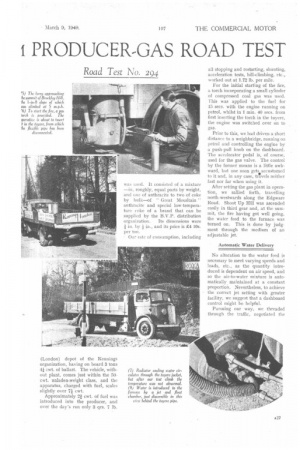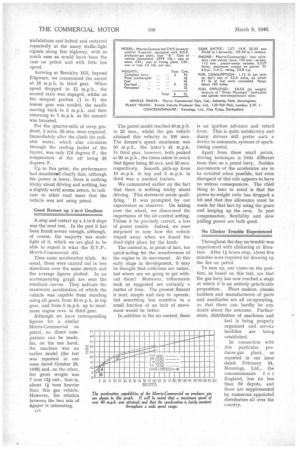PERFORMA\ CE POINTERS FR( t PRODUCER-GAS ROAD TEST
Page 36

Page 37

Page 38

If you've noticed an error in this article please click here to report it so we can fix it.
B.V.PMorris-Commercial Proves Satisfactory in All Respects; No Special Driving Technique Demanded; Hill-climbing and Acceleration Reasonably Close to Petrol Standards; Consumption Rate Good IN carrying out road tests of commercial vehicles, it has been the policy of this paper to avoid stunts and freak conditions. The system of testing has been, as a general rule, to observe performance on roads, such as the vehicle would normally be expected to use, but to afford scope for it to display its capabilities and to include difficulties of a sufficiently severe nature to ensure that no weakness, as compared with usual standards, should escape notice.
As a result, whilst the great majority of models submitted to us for test has come through with practically clean sheets, a number of failures has been recorded.
Normal Tests Unchanged Our reason for thus prefacing this report is that we wish to emphasize that there was no variation in the actual nature of the specific tests executed on this occasion, although the machine was running on solid fuel. One would expect the times, speeds, etc., to be inferior, afid the vehicle admittedly was not laden to capacity, but the hills used for two of the most important investigations A26 were those that have served us in the past on numerous occasions and which have proved quite troublesome on a few.
This trial is the first we have conducted of a vehicle operated on this fuel since producer gas gained its present position of recognized importance, and we believe this is the first full report of a producer-gas machine to be published.
The vehicle was a Morris-Commercial four-cylinder 5-tonner, equipped by Kennings, Ltd., with plant supplied by British Vehicle Producer Gas, Ltd. We set out on our test, during which 52.8 miles were traversed, from the Edgware Road
(London) depot of the Kennings organization, having on board 3 tons 41 cwt. of ballast. The vehicle, without plant, comes just within the 50cwt. unladen-weight class, and the apparatus, charged with fuel, scales slightly over 7/ cwt.
Approximately 21 cwt. of fuel was introduced into the producer, and over the day's run only 3 qrs. 7 lb.
was used. It consisted of a mixture —in, roughly, equal parts by weight, and one of anthracite to two of coke by bulk—of " Great Moudtain " anthracite and special low-temperature coke of a brand that can be supplied by the B.V.P. distribution organization. Its dimensions were 1 in. by in., and its price is £4 10s. per ton.
Our rate of consumption, including all stopping and restarting, shunting, acceleration tests, hill-climbing, etc., worked out at 1.72 lb. per mile.
For the initial starting of the fire, a torch incorporating a small cylinder of compressed coal gas was used. This was applied to the fuel for 15 secs. with the engine running on petrol, whilst in 1 min. 40 secs. from first inserting the torch in the tuyere, the engine was switched over on to gas.
Prior to this, we had driven a short distance to a weighbridge, running on petrol and controlling the engine by a push-pull knob on the dashboard. The accelerator pedal is, of course, used for the gas valve. The control by the former means is a little awkward, but one soon getseaccustomed to it and, in any case, travels neither fast nor far when using it.
After setting the gas plant in operation, we sallied forth, travelling north-westwards along the Edgware Road. Shoot Up Hill was ascended easily in third gear and, at the summit, the fire having got well going, the water feed to the furnace was turned on. This is done by judgment through the medium of an adjustable jet.
Automatic Water Delivery No alteration to the water feed is necessary to meet varying speeds and loads, etc., as the quantity introduced is dependent on air speed, and so the air-to-water mixture is automatically maintained at a constant proportion. Nevertheless, to achieve the correct jet setting with greater facility, we suggest that a dashboard control might be helpful.
Pursuing our way, we threaded through the traffic, negotiated the undulations and halted and restarted repeatedly at .the many traffic-light signals along this highway, with as much ease as would have been the case on petrol and with little less speed.
Arriving at Brockley Hill, beyond Edgware, we commenced the ascent at 18 m.p.h. in third gear. When speed dropped to 12 m.p.h., the second ratio was engaged, whilst on the steepest portion (1 in 8) the lowest gear was needed, the needle moving back to 5 m.p.h. and then returning to 7 m.p.h. as the summit was breasted.
For the quarter-mile of steep gradient, 2 mins. 56 secs. were required. Immediately after the climb the radiator water, which also circulates through the cooling jacket of the tuyere, was only 176 degrees F., the temperature of the air being 38 degrees F.
Up to this point, the performance had manifested clearly that, although the power is lower, there is nothing tricky about driving and nothing, bar a slightly acrid aroma astern, to indicate to other road users that the vehicle was not using petrol.
Good Restart up I-in-6 Gradient A stop and restart up a 1-in-6 slope was the next test. In the past it has been found severe enough, although, of course, the majority has made light of it, which we are glad to be able to report is what the B.V.P.Morris-Commercial did.
Then came acceleration trials. As usual, these were carried out in two directions over the same stretch and the average figures plotted. In an accompanying graph are seen the resultant curves. They indicate the maximum acceleration of which the vehicle was capable from standing using all gears, from 10 m.p.h. in top gear, and from 5 m.p.h. up to maximum engine revs, in third gear.
Although we have corresponding figures for a similar Morris-Commercial on petrol, no direct comparison can be made, for, on the one hand, the machine was an earlier model (the test was reported in our issue dated October 28, 1938) and, on the other, the gross weight was 7 tons 12* cwt., that is, about I* tons heavier than this gas vehicle. However, the relation between the -two sets of figures is interesting.
A.2s The petrol model reached 40 m.p.h. in 55 secs., whilst the gas vehicle attained this velocity in 100 secs. The former's speed maximum was 50 m.p.h., the latter's 41 m.p.h. In third gear, however, both peaked at 30 m.p.h., the times taken to reach that figure being 30 secs. and 50 secs. respectively. Smooth pick-up from 10 m.p.h. in top and 5 m.p.h. in third was a marked feature.
We commented earlier on the fact that there is nothing tricky about driving. This statement needs qualifying. ' It was prompted by our experiences as observer. On taking over the wheel, we discovered the importance of the air-control setting. Unless it be precisely correct, a loss of power results. Indeed, we were surprised to note how the vehicle leaped away when we found the dead-right place for the knob.
The control is, in point of fact, too quick-acting for the sensitiveness of the engine to its movement. At this early stage in development, it may be thought that criticisms are linfair, but where are we going to get without them? Moreover, refinements such as suggested are certainly a matter of time. The present fitment is neat, simple and easy to operate, but something less sensitive to a small fraction of an inch of movement would be better.
In addition to the air control, there is an ignition advance and retard lever. This is quite satisfactory and many drivers still prefer such a device to automatic systems of sparktiming control.
Apart from these small points, driving technique is little different from that on a petrol lorry. Sudden movements of the accelerator are to be avoided when possible, but even disregard of this rule appears to have no serious consequences. The chief thing to bear in mind is that the power-to-weight ratio has dropped a bit and that due allowance must be made for that fact by using the gears and keeping up the revs. In part compensation, flexibility and slow pulling power are both good.
No Clinker Trouble Experienced Throughout the day no trouble was experienced with clinkering or filtration. After 14 hours stop, about five minutes were required for drawing up the fire on petrol.
To sum up, our views on the position, as based on this test, are that the gas lorry has now reached a stage at which it is an entirely practicable proposition. Plant makers, chassis builders and manufacturers of parts and auxiliaries are all co-operating, so that there can hardly be any doubt about the outcome. Further more, distribution of machines and fuel is being properly organized and service facilities are being established.
In connection with this particular producer-gas plant, as reported in our issue dated February 24, Kennings, Ltd., the concessionnaire f o r England, has no less than 50 depots, and these are supplemented by numerous appointed distributors all over the country.




























































